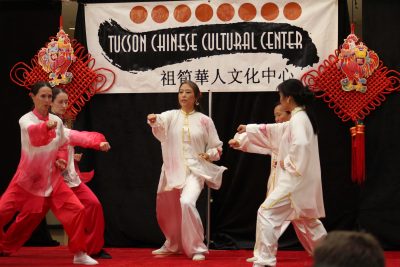
Celebrating the Chinese New Year at the Tucson Mall.
Happy Chinese New Year! The Chinese New Year began Jan. 28 and will last until February, 2018. It is the Year of the Rooster. In China, the new year’s celebration is also known as Spring Festival and is the country’s most important traditional festival. It is a time of celebration for families and is a week-long official public holiday. The Chinese New Year is also celebrated around the United States by Americans of Chinese ancestry, especially in large metropolitan areas where “China towns” were established.
In Arizona, Chinese New Year was celebrated in Phoenix with the Chinese Culture & Cuisine Festival on Feb. 10 – 12. The three days of cultural, social and educational events attracted thousands of participants who enjoyed the arts, food, dance, entertainment, history and heritage of China.
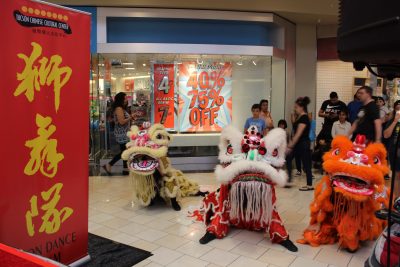
Traditional Chinese Dragons.
In Tucson the Year of the Rooster was celebrated by the Tucson Chinese Cultural Center at the Tucson Mall on Feb. 11. Both Tucson and Phoenix were influenced by Chinese immigrants as was much of Arizona. The Chinese arrived in the 1870s to work on the railroads where they were hired as cheap labor. Their pay was lower than that of Anglo workers. The Chinese overcame racial hatred and discrimination to play an important role in the development of transportation, agriculture and mining in Arizona.
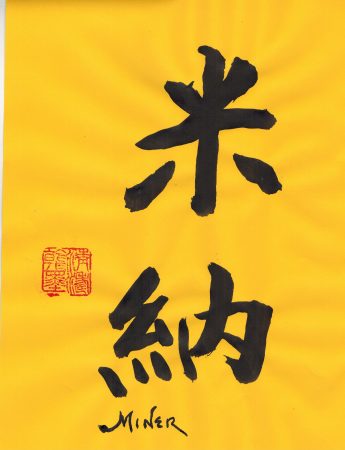
Chinese calligraphy depicting the name “Miner”
There were Chinese influences in towns along the Copper Corridor including Oracle, Mammoth, San Manuel, Superior, Ray-Sonora and Globe. Catherine Ellis, Oracle author and historian, wrote about Chinese cooks in Oracle in her article published in the Spring 2012 issue of The Journal of Arizona History. The article “Fong is in Charge of the Kitchen, Pioneer Cooks and the Culinary Life of Oracle” talked about Chinese cooks working at some of the ranches including the Acadia ranch, Rancho de los Robles, Bayless ranch, and Rancho Linda Vista. They were also known to have worked for well to do families in Oracle and the Mountain View Hotel. There was a Chinese restaurant and laundry in Mammoth as early as 1900.
The Mar Kim family established one of the first restaurants in the new mining town of San Manuel, Arizona which was involved in the social and business history of the town. The Kim family legacy goes back to the 1880s where their patriarch Sam Kee played an important part in the history of Ft. Huachuca.
Sam Kee and Mar Kim: Exploring the History of Fort Huachuca
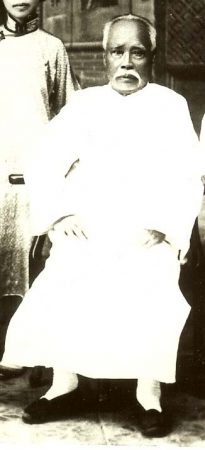
Sam Kee
Fort Huachuca was first established as a camp in 1877 as a result of the Indian wars of the 1870-1880s. Colonel August B. Kautz, Commander of the Department of Arizona ordered a camp constructed in the Huachuca Mountains for the protection of settlers and the travel routes in southeastern Arizona. It would also block the Apache escape routes through the San Pedro and Santa Cruz valleys to their sanctuaries in Mexico. It would be designated as a fort in 1882.
Two men who were a part of the fort’s colorful history were Sam Kee and his son Mar Kim. Sam Kee would become a legend and Mar Kim would also be a part of Tucson and San Manuel history.
Sam Kee was a Chinese immigrant who came to the United States with his brother to work on the railroads in the late 1800s. Kee also worked in the mines around Tombstone, Arizona. He saved his pay from the mines and railroad and decided to go into business on his own. He first established a laundry business and later with the help of his brother opened a fan-tan gambling parlor, which also served food and became noted for its pies. Sam’s brother had been a cook prior to joining him in Tombstone. Soldiers from Ft. Huachuca became regular customers at the parlor. Kee also had three wives, one in China and two in the United States.
Shortly after Camp Huachuca became a fort, Kee was approved to open a restaurant on the grounds of Fort Huachuca. The Post Café served Chinese and American food. It soon became popular among the soldiers and civilians. Civilian-owned restaurants were popular on military bases. It allowed the soldiers and officers a respite from the sometimes monotonous military food. Kee also operated the Post Dairy and the post trading store. In the spring of 1882 the Chinese Exclusion Act was passed by the United States government. As Kee’s labor force was entirely Chinese, this would impact his businesses. But Kee would use his ingenuity to resolve this problem.
The Chinese Exclusion Act was one of the most restrictive immigration laws in U.S. history. It prohibited the immigration of all Chinese laborers. The law was the first to prevent a specific ethnic group from immigrating to the country. One U.S. Senator an opponent of the bill called it “legalized racism”. It was supposed to last 10 years but was extended numerous times. It was not until 1943 that the Chinese were allowed to immigrate into the U.S. although the numbers were very limited. Large scale immigration would not happen until 1965.
Chinese workers were still needed in Mexico and were allowed to immigrate. This would make the northern borders of Mexico a conduit for Chinese labor into the United States. The first human smuggling operations in Mexico were set up to smuggle the Chinese not Mexicans. There is a good chance that Sam Kee may have been involved in the smuggling operations and he definitely benefited from them as he always had an ample supply of Chinese labor. There were tunnels underneath the Post Café where newly smuggled workers hid.
Kee was known to have had several run-ins with immigration officials. The most notable was with Immigration Service Inspector Jeff Milton. Jefferson Davis Milton wasn’t your ordinary immigration bureaucrat. He was a former Texas Ranger and had worked as a deputy sheriff in New Mexico and Arizona. It had been said that Milton killed three Mexicans in gun fights while a deputy in New Mexico. He got his reputation in Arizona while working as a Wells Fargo shotgun messenger on the Southern Pacific Railroad when he tried to stop a robbery by the noted Alvord-Stiles gang. During the robbery he killed “three fingered Jack” Dunlap and wounded another of the bandits. Milton was shot in the left arm and lost most of the use of it. In 1904 he was appointed to the Immigration Service as a mounted Chinese Inspector. In 1924 he would become the first Border Patrol agent at the age of 62.
On several occasions while inspecting the Post Café, Milton found illegal workers hiding in the building. Despite this, Sam Kee avoided or overcame legal troubles and always had available workers. Milton told a story of finding one of Kee’s “nephews” hiding underneath a loose floorboard in the cafe. Milton said that Kee offered him a “stipend” to let his nephew go. Milton arrested the worker suspected of recently arriving from Mexico. Two weeks later when Milton inspected the café again, he found the same immigrant working there. The worker had gone to court and been returned to Mr. Kee’s employment. No one had notified Milton about the court hearing where he could testify.
The legend surrounding Sam Kee grew during the years 1910 and 1911. In 1910 the War Department was considering abandoning Ft. Huachuca. At the same time the United States Congress was debating the budget. A delay in Congress passing the budget left the troops at Ft. Huachuca without pay. Sam Kee offered to make the payroll for the soldiers.
His offer was accepted by the post commander and Kee ended up paying the troops for three months. He would do it again in 1911. A newspaper reported that the monthly payroll in October 1911 was $20,000.
The story became so well known that Hollywood would use it for an episode of the television series “Death Valley Days” in 1959. The episode was titled Sam Kee and Uncle Sam. The series featured true stories of the American West.
Between 1912 and 1914 one of the post commanders tried to shutdown the Post Café claiming it was unsanitary and that he wanted Kee off the post. No one knows exactly what happened but it has been speculated that Kee had contacted or had someone at the base contact Major General Leonard Wood, a former post Army physician and friend who was now Army Chief of Staff. Wood was stationed at Ft. Huachuca during the Apache wars and was a recipient of the Medal of Honor for courage during the campaign to capture Geronimo. Whatever happened, Kee had someone in high places pull some strings. The post commander received a telegram from the Secretary of War ordering him to keep the Post Café open.
In 1919, Kee and his brother retired and taking their fortune with them returned to China. The Post Café was turned over to four of Kee’s nephews. The nephews managed the café with mixed results. During the Depression the Café suffered. Mar Kim finally took over and brought the café back to some of its original glory. Fort Huachuca has honored the legend of Sam Kee with building 22328 dedicated to his memory as a pioneer and entrepreneur who was important to Fort Huachuca and Arizona history.
Mar Kim was born in San Francisco in 1896. After taking over the Post Café, he operated it successfully until Ft. Huachuca closed following the end of World War II. Kim and his family moved to Tucson and opened the Far Eastside Market on Country Club. In 1956 he bought the San Manuel Café in the newly built booming mining town of San Manuel, Arizona.
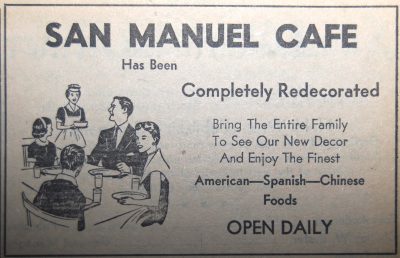
An advertisement in the San Manuel Miner for the San Manuel Cafe.
The San Manuel Café became a popular place to eat. Local businessmen and service organizations used it for meetings and special occasions. Magma Copper Company, the owner of the mine and town site, wined and dined investors, politicians and personnel from corporate headquarters. Gilbert Fong was the Chef and would remain with them until the final closure of the café. The café advertised that they served American, Spanish and Chinese foods and were open 6:30 a.m. to 8 p.m. every day. (Spanish food is what we call Mexican food today.)
In 1964, Mar Kim died leaving the restaurant to his wife Victoria. The ownership of the San Manuel Café would be transferred over to the Elks Club which was in an adjoining building in 1969. Eddie Kim, son of Mar, said that the 1967-68 strike had hurt the business especially when Magma Copper Company told them they had to remain open during the strike. Mar Kim not only played a part in Ft. Huachuca history but in San Manuel’s history as well. The San Manuel Café no longer exists but the Elks Club still uses the kitchen and building for community events.
A Note from the Author:
I would like to thank Gene Mar and his wife Janet for providing information and sources on Sam Kee and Ft. Huachuca. Gene is the great grandson of Sam Kee. His family settled in Safford where they carried on the entrepreneur spirit. They overcame prejudice along with five other Chinese families to open the Del Monte Market. They later owned the Star Café. Gene became a doctor. He also has ties to San Manuel. He ran a one day physical rehabilitation clinic at the San Manuel Hospital. He also went to school with Dr. Karl Hendrickson of Oracle. Gene gives talks on Sam Kee and the history of Ft. Huachuca.
Thanks to Eddie Kim for information on the San Manuel Café.
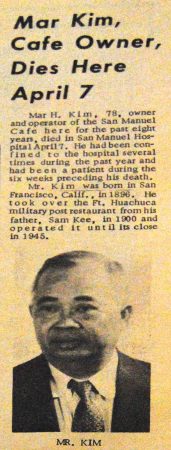
Clipped from the San Manuel Miner

